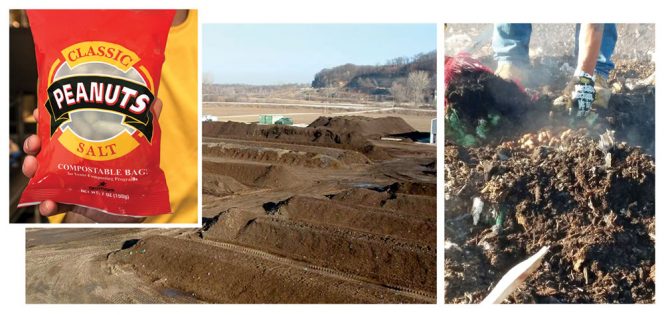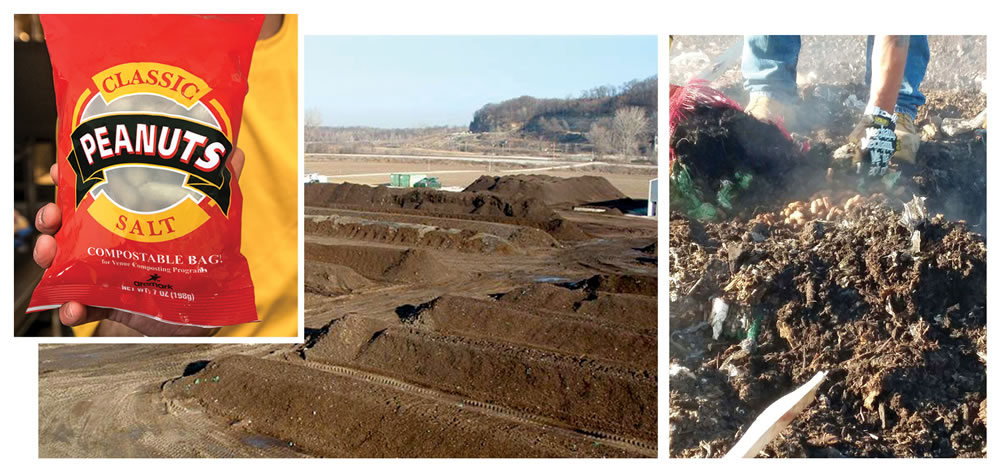Among the latest developments are formation of Green Sports Alliance Japan, and commercialization of a compostable peanut bag.
Marsha W. Johnston
BioCycle June 2018
 As the Green Sports Alliance (Alliance) enters its ninth year, the sports greening movement is experiencing increased international collaboration, domestic expansion and new practices and products that could make sporting operations intrinsically sustainable. Among the most recent examples is the establishment of its first international sister organization, in Japan. Although the Alliance’s membership already included teams, leagues and venues and individuals from 14 countries, Green Sports Alliance Japan is the first nation-member — and helps lay the groundwork for more global collaborations.
As the Green Sports Alliance (Alliance) enters its ninth year, the sports greening movement is experiencing increased international collaboration, domestic expansion and new practices and products that could make sporting operations intrinsically sustainable. Among the most recent examples is the establishment of its first international sister organization, in Japan. Although the Alliance’s membership already included teams, leagues and venues and individuals from 14 countries, Green Sports Alliance Japan is the first nation-member — and helps lay the groundwork for more global collaborations.
“There are countries and regions that are advanced well beyond America when it comes to climate change,” says Alliance Executive Director Justin Zeulner, noting that the nations party to the Paris climate accords have adopted more advanced laws and standards, and some have similar sports greening organizations. They use those organizations, such as the U.K.’s British Association for Sustainable Sport (BASIS) and Australia’s Sports & Environment Alliance, he adds, “to connect people” to those laws and standards. With establishment of Alliance Japan, he adds, “there may be a chance to establish other sister organizations in Korea and India. The EU Sports Commission is interested in a Green Sports Alliance Europe, as is the Union of European Football Associations (UEFA).”
European Commitments
In what could be a precursor to an Alliance Europe, the Alliance issued Playing for Our Planet, a report on environmental initiatives taking place across sports in Europe. Collaboratively produced by the Alliance, UEFA and World Wildlife Fund (WWF), the report was also supported by the European Commission and the United Nations Framework Convention on Climate Change.
In it, Joachem Verberne, Sydney 2000 Olympic medalist and WWF International Director of Global Partnerships, notes that the rationale for greening the sporting economy, which is valued at approximately one percent of global GDP (gross domestic product), is simple: “Sport both impacts and is dependent upon nature. Climate change threatens the viability of winter resorts while record-breaking heat waves affect athlete health and performance at summer events. Deteriorating water quality in oceans, rivers and lakes is negatively affecting sports like swimming, surfing, rowing, canoeing and sailing. And with impact and dependency comes responsibility.”
Playing for Our Planet tells how 25 stakeholders, including UEFA, European Athletics and the French Ministry of Sports, are working to integrate sustainability practices into and reduce the environmental impact of their sporting operations on everything from climate change to ocean plastics. While lauding the initiatives, it also calls for more substantive, long-term integration of environmental concerns into sports operations by, for example, adhering to quantifiable event sustainability standards such as the ISO 20121, which was developed for the London 2012 Olympic Games (see sidebar).
“Sport has to move from worthy but ad hoc greening and corporate social responsibility projects to anchoring with mainstream concerns,” writes David Stubbs, former head of sustainability for London 2012. “It has to fully embrace sustainability as a way of working.” Stubbs further asserts that only the International Olympic Committee (IOC), Olympic Organizing Committees and federations like World Sailing are truly tackling sustainability.
Indeed, possibly one of the most striking commitments to emerge in recent memory came from the Los Angeles 2028 Olympic Committee’s winning bid, with its “Radical Reuse” sustainability program. To avoid the environmental and carbon impact of traditional large construction projects, LA 2028 will not build any new permanent Olympic venues. Instead, it will leverage existing world-class venues, including using the University of California Los Angeles’ (UCLA) campus as the Olympic and Paralympic Village to create a historically low-carbon Games.
Many of those existing venue operators have implemented, or plan to implement, strong sustainability practices, such as energy-efficient LED lighting, multistream waste programs and staff/community sustainable education initiatives. A primary example is the LA Memorial Coliseum, which, under the management of the USC Office of Sustainability, achieved its Zero Waste Initiative goal in 2016, becoming the largest NFL stadium and second-largest collegiate stadium to achieve such a goal (see “Los Angeles Coliseum ‘Modernizes’ With Zero Waste,” June 2017).
Zeulner notes that the Paris 2024 Olympic committee has a similar plan, while other prospective Olympic cities are considering the same moves. “The game has changed,” explains Zeulner, who cofounded the Alliance in 2010. “It isn’t just about how an event will promote recycling and walking, or how a new venue facilitates biking. It goes way beyond, to how these mega events and new venues will be used to create real change and opportunities around social equity, environment and justice, to create legacy impacts that will persist for the next 20 to 50 years.”
These legacy initiatives are not unique to recent Olympic bids. In fact, this year’s Alliance Summit venue in Atlanta, Mercedes-Benz Stadium, is the first LEED Platinum professional stadium. It has an advanced storm water management system that includes 2.1 million gallons of on-site storage to help prevent the repeated flooding that has plagued its dense downtown Atlanta neighborhood. Its support for long-term neighborhood organization Westside Works is providing significant culinary and construction job opportunities.

Missouri Organic Recycling (MOR) conducted a field test of the compostable peanut bags in 2017.“The bags completely degraded in 49 days,”notes Kevin Anderson, Vice-President of MOR. Photos by Kevin Anderson
Compostable Peanut Bags
Another industry development has emerged that should fuel successful zero waste initiatives. The Kansas City Chiefs partnered with concessionaire Aramark, BASF, Missouri Organic Recycling, Hampton Farms, Futamura and TC UltraFlex Packaging to develop a compostable peanut bag, a long-time bane of composters serving sports venues.
Having seen BASF present information at the 2013 Alliance Summit on its pilot of a compostable peanut bag at the Seattle Mariners’ Stadium, Kansas City Chiefs’ Vice President of Stadium Operations and Facilities Brandon Hamilton approached Aramark, its concessionaire, in 2015. As head of An Extra Yard for the Environment, the Chiefs’ committee charged with waste diversion at Arrowhead Stadium, Hamilton was keenly aware of the need for a solution to chip bag contamination for its composter, Missouri Organic Recycling (MOR).
“We wanted to get to 100 percent compostable service items, but there were a few things we couldn’t figure out, and the peanut bag was one of them,” Hamilton notes. “I knew I needed the national reach of an Aramark or Levy [Restaurants] to place enough orders to get the Hampton Farms peanut supplier to change.”
Hamilton reached out to some national Aramark executives, who in turn approached BASF. Thomas Pitzi, sales manager of BASF’s biopolymers group in Wyandotte, Michigan, explains that, having proved with the Mariners’ pilot that it could make compostable packaging, the challenge was taking it from the prototype that BASF designed itself to a commercially viable product with input from every component maker and stakeholder. As the maker of just the ecovio resin and Epotal adhesive, BASF had to incorporate product specifications from its contractors Transcontinental-Ultraflex (flexible packaging) and Futamura (NatureFlex™ compostable barrier film), as well as Hampton Farms and MOR (see sidebar “Composting a Peanut Bag”).
After one false start in 2016, a field trial was done at MOR in 2017. Kevin Anderson, MOR vice president, put approximately 8 cases of the peanut-filled compostable bags into red mesh potato bags and shoved them into holes he dug in an active windrow. “The bag completely degraded in 49 days, and there were peanuts that didn’t compost,” Anderson notes. “The bag did better than the peanuts!”
Now, says Hamilton, the Chiefs encourage fans to leave their waste underneath their seats “because it’s actually easier for us to sort it than getting the fans to do. We go once, pick up recyclables, and everything that’s left is compostable at that point, so the food and everything goes to MOR.” Eliminating the peanut bag contamination has been helpful, adds Anderson, though more work remains to be done on contamination from aluminum foil and plastic popcorn containers.
The peanut bag is “a perfect example of what is needed for success, which is collaboration,” says the Alliance’s Zeulner. “It wasn’t just the Kansas City Chiefs, or BASF, or Aramark. It was all of them and the farmer, and that’s incredible. That’s why it will be sustainable.” The bag is also being sold at U.S. Bank Stadium in Minneapolis, after being introduced for the 2018 Super Bowl.
Drawing more and more collaborators into the green sports movement is clearly the aim of both the Alliance and its long-term members. Major League Baseball (MLB), for example, established a partnership with Arizona State University’s School of Sustainability to study and report on how to move MLB’s Cactus League spring training facilities more completely into the sports greening movement with zero waste implementation and fan engagement strategies.
“We’ve reached the tipping point in pro sports now,” says Zeulner. “We have surfers, sailors, snowboarders, and now we’re advancing NASCAR and golf at higher levels. We’re seeing critical mass around all of this.” With that critical mass, he adds, the movement can send a powerful signal to the entire sporting economy marketplace about the sustainable products it needs.
For Norman Vossschulte, director of fan experience for the Super Bowl LII champion Philadelphia Eagles and hosts of the 2019 Alliance Summit, the mission is “to turn our Go Green sustainability program into a model that can be adopted by our fans and communities everywhere, even beyond those who visit Lincoln Financial Field.”
Marsha W. Johnston, an editor with Earth Steward Associates, is a Contributing Editor to BioCycle.










